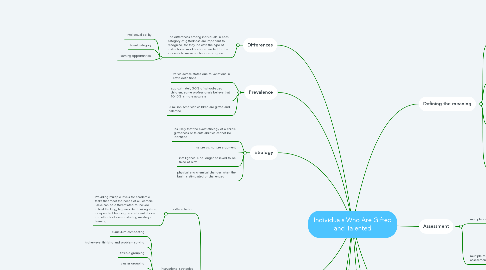
1. Differences
1.1. The differences among individuals in each category of giftedness are important to recognize, for they indicate the type of instructional modifications needed for the students to make continuous progress.
1.1.1. intellectual ability
1.1.2. talent category
1.1.3. learning opportunities
2. Prevalence
2.1. varies across states due to variations in state definitions
2.2. approximately 3-5% of school-aged children; some professionals believe that 10-15% is more accurate
2.3. 3 million American children are gifted and talented
3. Etiology
3.1. it's likely that the exact etiology of a child’s giftedness or talents abilities cannot be identified
3.2. nature vs. nurture argument
3.3. intelligence is no longer believed to be fixed at birth
3.4. physical and chemical changes when the brain is stimulated or challenged
4. Educational considerations
4.1. differentiation
4.1.1. Providing multiple levels for academic tasks that meet the needs of all learners. Tasks can be differentiated to include critical thinking, higher-order thinking skills, independent learning, and student choice in methods of demonstrating mastery of learning.
4.2. instructional strategies
4.2.1. curriculum compacting
4.2.2. higher-level thinking and problem solving
4.2.3. flexible grouping
4.2.4. cluster grouping
4.2.5. tiered assignments
4.2.6. problem-based learning
4.2.7. pacing instruction
4.2.8. creativity
4.3. service delivery options
4.3.1. gifted resource services
4.3.2. acceleration
4.3.3. independent study
4.3.4. honors and AP courses
4.3.5. mentorships
4.4. self-contained classes and special schools
4.4.1. summer and Saturday programs
4.4.2. competitions
5. Adolescents and Adults
5.1. adolescents need to "fit in"
5.2. "personality attributes well suited to the difficult struggle of establishing their mastery over a domain: a desire to achieve, persistence, and a curiosity and openness to experience"
5.3. MENSA is an international social organization for individuals who have an IQ in the top 2 percent of the general population
5.4. one of the key questions confronting professionals is how best to meet the educational needs of young people who are gifted and talented
6. Trends, issues, and controversials
6.1. The Excellence Gap
6.1.1. 1. Make high-performing students highly visible. 2. Remove barriers that prevent high-ability students from moving through coursework at a pace that matches their achievement level. 3. Ensure that all high-ability students have access to advanced educational services. 4. Hold local education agencies accountable for the performance of high-ability students from all economic backgrounds.
6.2. striving for world class standards
6.2.1. Assumptions are often made that children who are gifted and talented will learn in spite of their circumstances. On the contrary, students who are gifted are less likely to make a years achievement gain than are other students.
6.3. equity and excellence
6.3.1. All children deserve an educational program that challenges them.
6.4. full inclusion
6.4.1. Full inclusion may not be the least restrictive environment for children who are gifted and talented.
6.5. services for gifted students instead of the gifted program
6.5.1. For all children, the learning ceiling must be removed, allowing them to learn what they are ready to learn, at a pace that will encourage them to maintain interest.
6.6. talent development
6.6.1. The development of our most talented students is essential if our communities, states, nations, and world are to thrive in the future.
7. Defining the meaning
7.1. Each state establishes its own definition of children who are gifted and talented.
7.2. During the early twentieth-century, giftedness was generally equated with high intelligence as measured by IQ (intelligence quotient) testing. This narrow definition has expanded in recent years although states are able to create their own definitions for determining giftedness and talent.
7.3. Children capable of high performance include those with demonstrated achievement and/or potential ability in any of the following areas:
7.3.1. general intellectual ability
7.3.2. specific academic aptitude
7.3.3. creative or productive thinking
7.3.4. leadership ability
7.3.5. visual and performing arts
7.3.6. psychomotor ability
7.4. Gifted Behavior as Portrayed by Renzulli’s “Three -Ring” Model
7.4.1. above average abilities
7.4.2. task commitment
7.4.3. creativity
8. Assessment
8.1. multiple areas of assessment
8.1.1. strengths
8.1.2. interests
8.1.3. leaderships
8.1.4. intellectual ability
8.1.5. academic achievement
8.1.6. creativity
8.2. multiple tools, informants, and types of assessments
9. Characteristics
9.1. academic and learning
9.1.1. Any of these characteristics may resemble all children but children who are gifted and talented will display a greater degree or intensity than their peers. Understanding of their unique strengths and needs is essential for a challenging academic curriculum.
9.2. social and emotional
9.2.1. Students who are gifted and talented often experience social and emotional difficulties related to their talents, for example, a student who has excellent verbal skills may dominate classroom conversations.
9.3. children who are gifted and talented may not show advanced abilities in all areas or at all times and educational opportunities must be tailored to meet their unique needs
10. Services for Young Children
10.1. early experiences
10.2. identification difficulties due to age
10.3. lack of federal legislation
11. Issues of Diversity
11.1. Challenge of identifying and serving children with gifts and talents from diverse backgrounds.
11.2. Twice exceptional learners
11.2.1. Stereotypes often assume that people with disabilities cannot also be gifted or talented. Many students who are gifted or talented may also have a disability.
11.2.2. A combination of learning factors may make correct diagnosis difficult.
11.3. Girls who are gifted learners
11.3.1. There is ample evidence to suggest that girls are often underrepresented in programs for students who are gifted and talented.
11.3.2. These statistics may be due to gender-role cultural stereotypes, unequal educational opportunities, and expectations of the school, family, and the girl.
11.4. Identifying and serving children from diverse backgrounds
11.4.1. Children who are gifted and talented come from all socioeconomic, racial, and ethnic groups.
11.5. Cultural characteristics associated with giftedness
11.5.1. Ten attributes of giftedness were identified in African American, Native American, and Hispanic children: communication skills, imagination/ creativity, humor, inquiry, insight, interests, memory, motivation, problem solving, reasoning.

